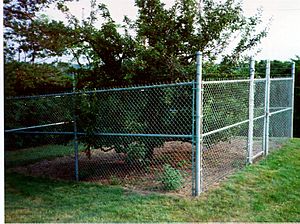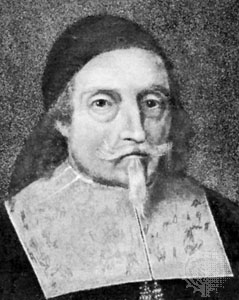Endicott Pear Tree facts for kids
Quick facts for kids 'Endicott' pear |
|
|---|---|

The Endicott Pear Tree in 1997
|
|
| Genus | Pyrus |
| Species | Pyrus communis |
| Cultivar | 'Endicott' |
The Endicott Pear Tree is a very old European Pear tree. It is found in Danvers, Massachusetts. Many people believe it is the oldest living cultivated fruit tree in North America.
Contents
History of the Endicott Pear Tree
How the Tree Started

The Endicott Pear Tree was planted a very long time ago, between 1632 and 1649. It was planted by John Endecott, who was an early governor of the Massachusetts Bay Colony. He was one of the first settlers in the area. The tree was probably brought from England on a ship called the Arbella in June 1630. Some reports say it might have arrived in 1628.
Stories say that Governor Endecott himself planted the tree. He supposedly did it with his children and farmworkers watching. He is said to have hoped the tree would "love the soil of the old world." He also hoped it would still be alive long after he was gone.
Some people think the tree might have been moved from Endecott's garden in Salem. An old article from 1852 suggests this. It also says that Endecott was probably one of the first people to grow fruit in the Massachusetts Bay Colony.
The Tree in the 1800s
A man named William Bentley kept a diary. He visited the Endecott estate many times starting in 1800. His diary shows that the pear tree always produced fruit. In 1809, Bentley even sent some pears from the tree to former President John Adams. President Adams wrote back to thank him for the pears. Bentley later sent Adams twigs from the tree, hoping he could grow his own.
The Endicott Pear Tree faced some tough weather. It was damaged by big storms, like hurricanes, in 1804, 1815, and 1843. But each time, it recovered and kept growing fruit. By 1875, the tree was about 80 feet (24 meters) tall! Later in the 1800s, a wooden fence was put up to help protect the tree.
The Tree in the 1900s
In the early 1900s, a plant expert named Ulysses Prentiss Hedrick studied the tree. He wrote a book called The Pears of New York. He confirmed that the Endicott Pear Tree had not been grafted. Grafting is when parts of two plants are joined to grow as one.
In 1919, another author, James Raymond Simmons, described the tree. He said that soil had built up around its base. This made its two main branches look like separate trees coming out of the ground. He also mentioned the protective fence around it. He saw the tree covered in green fruit and called it "one of the most quaint and strangely impressive of all the historic trees."
The tree was damaged by another hurricane in 1934. In the 1940s, a group called The National Grange tried to buy the tree's land. This was because the owner at the time had removed soil near the tree, which was bad for it. The town of Danvers also tried to get the land in 1946 but couldn't agree on terms with the owner.
Later, the land where the tree stands was owned by different companies. On July 27, 1964, some vandals cut off most of the tree's branches. They left only about 6 feet (1.8 meters) of its trunk. Even after this damage, the tree survived!
In 1997, scientists took small pieces, called scions, from the Endicott Pear Tree. They used these pieces to grow a clone of the tree. This clone now grows in a special collection in Corvallis, Oregon.
Why the Tree is Important
The Endicott Pear Tree is very special. In 2011, it was named a national monument of the United States. This means it's a very important historical site.
Many people in Danvers love the Endicott Pear Tree. In 2004, a local group even tried to get the tree featured on a United States Postal Service stamp.
A poet named Lucy Larcom wrote a poem about the tree in 1890. It was called "The Governor's Tree."
Images for kids



